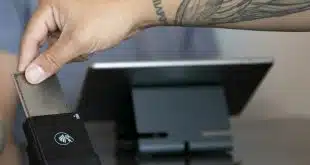By Kevin Woodward
n
A mobile point-of-sale service called Sequoia is promising card-present transaction rates for merchants using it, says developer 1Oak Technologies.
n
The technology requires consumers to use the free Sequoia app on their smart phones, and merchants to attach a radio-wave receiver to their point-of-sale terminals. The scheme works like this: When a consumer is ready to pay at a participating merchant, she opens the app, selects the payment card to use, and touches “pay” within the app. A payment card number is entered into the app by typing it on the smart phone.
n
Using technology already inside smart phones, the app then creates an encrypted radio wave that is picked up by the Sequoia receiver attached to the payment terminal. That device creates a magnetic-stripe transmitter signal—broadcast to a radius of about 2-inches—that is sent wirelessly to the payment terminal. The card reader then picks up the signal and processes the transaction as if an actual card was swiped, says Gary Rayner, 1Oak Technologies chief innovation officer.
n
The sales clerk then enters the transaction amount into the POS terminal for authorization. “What we’ve been able to do with elementary physics is we have a created a radio wave,” Rayner says. This does not require a Bluetooth or near-field communication (NFC) interface. 1Oak Technologies is based in Fort Collins, Colo.
n
The Sequoia device can capture both Track 1 and Track 2 data from the payment card, says Aaron Finch, 1Oak chief executive and president. “Which data is transmitted to the POS terminal will depend on which track the terminal prefers,” Finch says.
n
The card-present distinction is notable because many mobile payment schemes, particularly the ones relying on contactless technology, usually are processed at card-not-present rates, which are higher than card-present rates.
n
Sequoia is banking on attracting merchants with the lower processing fees and the ease of installation, Finch says. “What’s unique about this on the retail side is the ease of installation and the fairly low cost,” Finch says. Merchants only need to affix the Sequoia receiver to a payment terminal to begin accepting payments, he says. Cost of the device is not determined yet, he says. Finch is looking for partners to commercialize the technology.
n
Of course, those partners will face a challenge to convince merchants to adopt Sequoia as well as figuring out how to get the mobile POS service visible to consumers. Rayner says the low cost and ease of installation will help with merchants. “Once available to retailers, consumer adoption will go very high,” says Finch.
n
That may work, suggest analysts. “M-commerce needs to be inexpensive, secure, and easy,” says Mary Monahan, executive vice president and research director for mobile at payments research firm Javelin Strategy & Research, Pleasanton, Calif. “Sequoia is providing a low price point for their mobile payment system coupled with a convenient, ubiquitous service that works on every smart phone.”
n
But Sequoia has a long way to go in others’ estimation. “It should reduce the cost of mobile payment acceptance for many merchants, provided that the appropriate products can be built on top of it to create more demand from consumers and merchants alike,” says Rick Oglesby, senior analyst at Aite Group, a Boston-based consulting firm. “In essence, this is a good raw material, but there’s more work to do.”
n
Yet, it may not be simple enough. “The problem is just because it’s not asking merchants to make investments, it’s not changing the process,” says James Wester, a senior analyst who follows mobile payments at IDC Financial Insights, Framingham, Mass. “It’s still a matter of adding any value to the process.”
n
As for the value of enabling card-present transaction rates, Wester suggests that alone is not enough to spur widespread adoption. “As long as they’re asking the consumer to download something, there’s still a change to the process,” he says. “It’s a smart idea to get merchants to use their existing POS terminals, but it doesn’t necessarily solve the problem on either side, and that’s the thing to address.”





